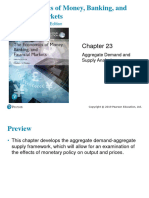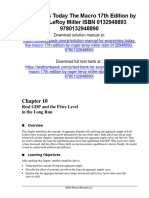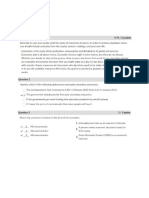0 ratings0% found this document useful (0 votes)
62 viewsAD As Analysis Chapter 23 Mishkin
AD As Analysis Chapter 23 Mishkin
Uploaded by
mahamCopyright:
© All Rights Reserved
Available Formats
Download as PPTX, PDF, TXT or read online from Scribd
AD As Analysis Chapter 23 Mishkin
AD As Analysis Chapter 23 Mishkin
Uploaded by
maham0 ratings0% found this document useful (0 votes)
62 views40 pagesOriginal Title
AD as Analysis Chapter 23 Mishkin (1)
Copyright
© © All Rights Reserved
Available Formats
PPTX, PDF, TXT or read online from Scribd
Share this document
Did you find this document useful?
Is this content inappropriate?
Copyright:
© All Rights Reserved
Available Formats
Download as PPTX, PDF, TXT or read online from Scribd
Download as pptx, pdf, or txt
0 ratings0% found this document useful (0 votes)
62 views40 pagesAD As Analysis Chapter 23 Mishkin
AD As Analysis Chapter 23 Mishkin
Uploaded by
mahamCopyright:
© All Rights Reserved
Available Formats
Download as PPTX, PDF, TXT or read online from Scribd
Download as pptx, pdf, or txt
You are on page 1of 40
The Economics of Money, Banking, and
Financial Markets
Twelfth Edition, Global Edition
Chapter 23
Aggregate Demand and
Supply Analysis
Copyright © 2019 Pearson Education, Ltd.
Aggregate Demand (1 of 3)
• Aggregate demand is made up of four component parts:
– consumption expenditure: the total demand for consumer
goods and services
– planned investment spending: the total planned spending
by business firms on new machines, factories, and other
capital goods, plus planned spending on new homes
– government purchases: spending by all levels of
government (federal, state, and local) on goods and
services
– net exports: the net foreign spending on domestic goods
and services
Copyright © 2019 Pearson Education, Ltd.
Aggregate Demand (2 of 3)
• The aggregate demand curve is downward
sloping because
and
Copyright © 2019 Pearson Education, Ltd.
Aggregate Demand (3 of 3)
• The fact that the aggregate demand curve is downward
sloping can also be derived from the quantity theory of
money analysis.
• If velocity stays constant, a constant money supply implies
constant nominal aggregate spending, and a decrease in
the price level is matched with an increase in aggregate
demand.
• Meaning of the term autonomous.
Copyright © 2019 Pearson Education, Ltd.
Figure 1 Leftward Shift in the Aggregate
Demand Curve
Copyright © 2019 Pearson Education, Ltd.
Figure 2 Rightward Shift in the Aggregate
Demand Curve
Copyright © 2019 Pearson Education, Ltd.
Factors That Shift the Aggregate Demand
Curve
• An increase in the money supply shifts AD to the right:
holding velocity constant, an increase in the money supply
increases the quantity of aggregate demand at each price
level.
• An increase in spending from any of the components C, I,
G, NX will also shift AD to the right.
Copyright © 2019 Pearson Education, Ltd.
Summary Table 1 Factors That Shift the
Aggregate Demand Curve
Copyright © 2019 Pearson Education, Ltd.
Aggregate Supply
• Long-run aggregate supply curve:
– Determined by the amount of capital and labor and the
available technology
– Vertical at the natural rate of output generated by the
natural rate of unemployment
• Short-run aggregate supply curve:
– Wages and prices are sticky
– Generates an upward sloping SRAS as firms attempt
to take advantage of short-run profitability when price
level rises
Copyright © 2019 Pearson Education, Ltd.
Figure 3 Long- and Short-Run Aggregate
Supply Curves
Copyright © 2019 Pearson Education, Ltd.
Shifts in Aggregate Supply Curves
• Shifts in the long-run aggregate supply curve
– The long-run aggregate supply curve shifts to the right
from when there is
1. An increase in the total amount of capital in the
economy
2. An increase in the total amount of labor supplied in
the economy
3. An increase in the available technology, or
4. A decline in the natural rate of unemployment
– An opposite movement in these variables shifts the
LRAS curve to the left.
Copyright © 2019 Pearson Education, Ltd.
Figure 4 Shift in the Long-Run Aggregate
Supply Curve
Copyright © 2019 Pearson Education, Ltd.
Shifts in the Short-Run Aggregate Supply
Curve
• There are three factors that can shift the short-run
aggregate supply curve:
1. Expected inflation
2. Price shocks
3. A persistent output gap
Copyright © 2019 Pearson Education, Ltd.
Summary Table 2 Factors That Shift the
Short-Run Aggregate Supply Curve
Copyright © 2019 Pearson Education, Ltd.
Figure 5 Shift in the Short-Run Aggregate Supply Curve
from Changes in Expected Inflation and Price Shocks
Copyright © 2019 Pearson Education, Ltd.
Figure 6 Shift in the Short-Run Aggregate Supply
Curve from a Persistent Positive Output Gap
Copyright © 2019 Pearson Education, Ltd.
Equilibrium in Aggregate Demand and
Supply Analysis
• We can now put the aggregate demand and supply curves
together to describe general equilibrium in the economy,
when all markets are simultaneously in equilibrium at the
point where the quantity of aggregate output demanded
equals the quantity of aggregate output supplied.
Copyright © 2019 Pearson Education, Ltd.
Short-Run Equilibrium
• Figure 7 illustrates a short-run equilibrium in which the
quantity of aggregate output demanded equals the quantity
of output supplied.
• The short-run aggregate demand curve AD and the short-
run aggregate supply curve AS intersect at point E with an
equilibrium level of aggregate output at and an equilibrium
inflation rate at .
Copyright © 2019 Pearson Education, Ltd.
Figure 7 Short-Run Equilibrium
Copyright © 2019 Pearson Education, Ltd.
Figure 8 Adjustment to Long-Run Equilibrium
in Aggregate Supply and Demand Analysis
Copyright © 2019 Pearson Education, Ltd.
Self-Correcting Mechanism
• Regardless of where output is initially,
it returns eventually to the natural rate.
• Slow:
– Wages are inflexible, particularly downward
– Need for active government policy
• Rapid:
– Wages and prices are flexible
– Less need for government intervention
Copyright © 2019 Pearson Education, Ltd.
Changes in Equilibrium: Aggregate Demand
Shocks
• With an understanding of the distinction between the short-
run and long-run equilibria, you are now ready to analyze
what happens when there are demand shocks, shocks that
cause the aggregate demand curve to shift.
Copyright © 2019 Pearson Education, Ltd.
Figure 9 Positive Demand Shock
Copyright © 2019 Pearson Education, Ltd.
Figure 10 The Volcker Disinflation: 1980–
1986
Source: Economic Report of
the President.
Copyright © 2019 Pearson Education, Ltd.
Figure 11 Negative Demand Shocks, 2000–
2004
Source: Economic Report of
the President.
Copyright © 2019 Pearson Education, Ltd.
Changes in Equilibrium: Aggregate Supply
(Price) Shocks (1 of 2)
• The aggregate supply curve can shift from temporary
supply (price) shocks in which the long-run aggregate
supply curve does not shift, or from permanent supply
shocks in which the long-run aggregate supply curve does
shift.
Copyright © 2019 Pearson Education, Ltd.
Changes in Equilibrium: Aggregate Supply
(Price) Shocks (2 of 2)
• Temporary Supply Shocks:
– When the temporary shock involves a restriction in
supply, we refer to this type of supply shock as a
negative (or unfavorable) supply shock, and it results
in a rise in commodity prices.
– A temporary positive supply shock shifts the short-
run aggregate supply curve downward and to the
right, leading initially to a fall in inflation and a rise in
output. In the long run, however, output and inflation
will be unchanged (holding the aggregate demand
curve constant).
Copyright © 2019 Pearson Education, Ltd.
Figure 12 Temporary Negative Supply
Shock
Copyright © 2019 Pearson Education, Ltd.
Figure 13 Negative Supply Shocks, 1973–
1975 and 1978–1980
Source: Economic Report of the
President.
Copyright © 2019 Pearson Education, Ltd.
Permanent Supply Shocks and Real
Business Cycle Theory
• A permanent negative supply shock—such as an increase in ill-
advised regulations that causes the economy to be less
efficient, thereby reducing supply—would decrease potential
output and shift the long-run aggregate supply curve to the left.
• Because the permanent supply shock will result in higher prices,
there will be an immediate rise in inflation and so the short-run
aggregate supply curve will shift up and to the left.
• One group of economists, led by Edward Prescott of Arizona
State University, believe that business cycle fluctuations result
from permanent supply shocks alone and their theory of
aggregate economic fluctuations is called real business cycle
theory.
Copyright © 2019 Pearson Education, Ltd.
Figure 14 Permanent Negative Supply
Shock
Copyright © 2019 Pearson Education, Ltd.
Figure 15 Positive Supply Shocks, 1995–
1999
Source: Economic
•
Report of the President.
Copyright © 2019 Pearson Education, Ltd.
Conclusions
• Aggregate demand and supply analysis yields the following
conclusions:
1. A shift in the aggregate demand curve affects output only
in the short run and has no effect in the long run.
2. A temporary supply shock affects output and inflation only
in the short run and has no effect in the long run (holding
the aggregate demand curve constant).
3. A permanent supply shock affects output and inflation both
in the short and the long run.
4. The economy has a self-correcting mechanism that returns
it to potential output and the natural rate of unemployment
over time.
Copyright © 2019 Pearson Education, Ltd.
Figure 16 Negative Supply and Demand
Shocks and the 2007–2009 Crisis
Source: Economic Report of
the President.
Copyright © 2019 Pearson Education, Ltd.
AD/AS Analysis of Foreign Business Cycle
Episodes
• Our aggregate demand and supply analysis also can help
us understand business cycle episodes in foreign
countries.
– Figure 17 shows the UK Financial Crisis, 2007–2009
– Figure 18 shows China and the Financial Crisis, 2007–
2009
Copyright © 2019 Pearson Education, Ltd.
Figure 17 U.K. Financial Crisis, 2007–2009
Source: Office of National Statistics, UK.
http://www.statistics.gov.uk/statbase/tsdt
imezone.asp.
Copyright © 2019 Pearson Education, Ltd.
Figure 18 China and the Financial Crisis,
2007–2009
Copyright © 2019 Pearson Education, Ltd.
Figure 2 The Short- and Long-Run Phillips
Curve
Copyright © 2019 Pearson Education, Ltd.
Three Important Conclusions
1. There is no long-run trade off between unemployment
and inflation.
2. There is a short-run trade off between unemployment
and inflation.
3. There are two types of Phillips curves, long run and short
run.
Copyright © 2019 Pearson Education, Ltd.
Copyright © 2019 Pearson Education, Ltd.
You might also like
- ECN 204 Final Exam ReviewDocument24 pagesECN 204 Final Exam ReviewLinette YangNo ratings yet
- Case 3 SunPowerDocument9 pagesCase 3 SunPowerMariaNo ratings yet
- Eco 102 Final Exam Sample QuestionsDocument7 pagesEco 102 Final Exam Sample Questionsdeprimenthia89100% (1)
- HomeworkDocument6 pagesHomeworkhbuzdar0% (2)
- Econ 155 MT 1 SlidesDocument264 pagesEcon 155 MT 1 SlidesRushil SurapaneniNo ratings yet
- Mishkin Embfm12ege Ch23Document49 pagesMishkin Embfm12ege Ch23Muhammad ButtNo ratings yet
- Chapter 23 Aggregate Demand and Supply AnalysisDocument54 pagesChapter 23 Aggregate Demand and Supply AnalysisTRAM NGUYEN NHU QUYNHNo ratings yet
- Lecture 6 AD ASDocument40 pagesLecture 6 AD ASJoey YUNo ratings yet
- Parkin - Econ - Lecture - Notes - ch27 Aggregate Supply and DemandDocument45 pagesParkin - Econ - Lecture - Notes - ch27 Aggregate Supply and Demand9c696qbzngNo ratings yet
- Parkinmacro10 1300Document18 pagesParkinmacro10 1300Mr. JahirNo ratings yet
- Mishkin Embfm12ege Ch21Document29 pagesMishkin Embfm12ege Ch21محمد ابوشريفNo ratings yet
- Chapter_11 the Determination of Aggregate Output, The Price Level, And the Interest Rate CFO_6a797a4436622bd97c8efaaf7239e8baDocument41 pagesChapter_11 the Determination of Aggregate Output, The Price Level, And the Interest Rate CFO_6a797a4436622bd97c8efaaf7239e8bamr eggesNo ratings yet
- Aggregate Supply DemandDocument9 pagesAggregate Supply DemandDom PaciaNo ratings yet
- Lecture 15Document41 pagesLecture 15ktthuy6102003No ratings yet
- Immediate download Macroeconomics 9th Edition Boyes Solutions Manual all chaptersDocument51 pagesImmediate download Macroeconomics 9th Edition Boyes Solutions Manual all chaptersbancoholeynn100% (1)
- Instant Download For Macroeconomics 9th Edition Boyes Solutions Manual 2024 Full Chapters in PDFDocument51 pagesInstant Download For Macroeconomics 9th Edition Boyes Solutions Manual 2024 Full Chapters in PDFsapelophalli100% (1)
- Prayoga Dwi N - Summary CH 27Document4 pagesPrayoga Dwi N - Summary CH 27Prayoga Dwi NugrahaNo ratings yet
- MBA. SEM 1 ECONOMICS FOR MANAGERSDocument32 pagesMBA. SEM 1 ECONOMICS FOR MANAGERSsangitshane1708No ratings yet
- Mishkin Embfm12ege ch22Document18 pagesMishkin Embfm12ege ch22محمد ابوشريفNo ratings yet
- Chapter 24 Monetary Policy TheoryDocument39 pagesChapter 24 Monetary Policy TheoryTRAM NGUYEN NHU QUYNHNo ratings yet
- 1.11 Aggregate Supply and Aggregate Demand: Learning OutcomesDocument11 pages1.11 Aggregate Supply and Aggregate Demand: Learning OutcomesDeepak SinghNo ratings yet
- Macroeconomics: Introduction To Economic FluctuationsDocument40 pagesMacroeconomics: Introduction To Economic Fluctuationsnazia naziaNo ratings yet
- Economics Today The Macro 17th Edition Roger LeRoy Miller Solutions Manual DownloadDocument9 pagesEconomics Today The Macro 17th Edition Roger LeRoy Miller Solutions Manual DownloadJeremy Jackson100% (21)
- Inflation & UnemploymentDocument13 pagesInflation & UnemploymentSamia Irshad ullahNo ratings yet
- The AD-AS ModelDocument44 pagesThe AD-AS Modeljoseswartzsr31No ratings yet
- Econ Ch29 Lecture PresentationDocument53 pagesEcon Ch29 Lecture PresentationMelody LatiNo ratings yet
- Lecture 5Document34 pagesLecture 5Robert OoNo ratings yet
- Slides Lecture 5 31032021 111144amDocument39 pagesSlides Lecture 5 31032021 111144amMuhammad SarmadNo ratings yet
- Lesson 4: The Full Macroeconomic Model ObjectivesDocument26 pagesLesson 4: The Full Macroeconomic Model ObjectivesAChristensen1299No ratings yet
- Chapter 27 Lecture PresentationDocument45 pagesChapter 27 Lecture PresentationSiti AtikahNo ratings yet
- Mishkin Econ13e PPT 21Document21 pagesMishkin Econ13e PPT 21aleema anjumNo ratings yet
- FA1314 Essentials of Economics - Lesson 1112 - STUDENTSDocument40 pagesFA1314 Essentials of Economics - Lesson 1112 - STUDENTSCHEAH� GUO XINGNo ratings yet
- Lesson 4b InflationDocument19 pagesLesson 4b InflationGaurav Kumar ChandelNo ratings yet
- Ch. 22 & 23 - As-AD Analysis - PostedDocument35 pagesCh. 22 & 23 - As-AD Analysis - PostedEslam HendawiNo ratings yet
- University of Liberal Arts Bangladesh (ULAB)Document13 pagesUniversity of Liberal Arts Bangladesh (ULAB)HasanZakariaNo ratings yet
- ch23 Mish11ge EmbfmDocument48 pagesch23 Mish11ge EmbfmRakib HasanNo ratings yet
- Answer Kye Ad and AsDocument6 pagesAnswer Kye Ad and Asdishakrishna2076No ratings yet
- AS-AD ModelDocument5 pagesAS-AD ModelSunil VuppalaNo ratings yet
- Intros 2Document7 pagesIntros 2drfendiameenNo ratings yet
- Lecture FiveDocument7 pagesLecture FiveKipngetich DanielNo ratings yet
- ch23 Mish11ge EmbfmDocument48 pagesch23 Mish11ge Embfm22313022No ratings yet
- Chapter 7 Macro Lecture PresentationDocument38 pagesChapter 7 Macro Lecture PresentationalsinanhananNo ratings yet
- Aggregate Supply & Aggregate DemandDocument51 pagesAggregate Supply & Aggregate DemandRahul ShakyaNo ratings yet
- Mankiw11e Lecture Slides Ch11Document55 pagesMankiw11e Lecture Slides Ch11vtgrkxhdh8No ratings yet
- ECON203 - Chapter 8Document24 pagesECON203 - Chapter 8vlad.dingerNo ratings yet
- Aggregate Demand and Aggregate SupplyDocument4 pagesAggregate Demand and Aggregate SupplyAMMAR AZAMNo ratings yet
- IMT Covid19Document6 pagesIMT Covid19Arjun RajNo ratings yet
- Trade Foreign UniversiDocument7 pagesTrade Foreign Universi22070615No ratings yet
- AP Macroeconomics: Unit 4 ReviewDocument4 pagesAP Macroeconomics: Unit 4 ReviewGo TurpinNo ratings yet
- CH21 Mish11ge EMBFMDocument36 pagesCH21 Mish11ge EMBFMnoura alsubaieNo ratings yet
- Meet 10Document44 pagesMeet 10Savana AndiraNo ratings yet
- MECO121 UM S2024 Session17Document30 pagesMECO121 UM S2024 Session17rizwanf026No ratings yet
- Lecture Note 6 Aggregate Demand and Aggregate SupplyDocument12 pagesLecture Note 6 Aggregate Demand and Aggregate Supplyphilipdenmark849No ratings yet
- Lec 5 (Aggregate Supply and Aggregate Demand - CH 27)Document45 pagesLec 5 (Aggregate Supply and Aggregate Demand - CH 27)Azaf AfzalNo ratings yet
- Powerpoint Presentation Long-Run Aggregate Supply and DemandDocument49 pagesPowerpoint Presentation Long-Run Aggregate Supply and DemandVivek Mishra100% (1)
- AD-AS ModelDocument6 pagesAD-AS Modeljujujue.03No ratings yet
- W10 Topic 7.AD & ASDocument36 pagesW10 Topic 7.AD & AS刘家亨100% (1)
- Macroeconomics & Business Environment: Mba Sem IiDocument65 pagesMacroeconomics & Business Environment: Mba Sem IiG74GARV SETHINo ratings yet
- Unit 3 Review Session Original KEYDocument6 pagesUnit 3 Review Session Original KEYHenry DunaNo ratings yet
- CHAP 33 - Group3Document15 pagesCHAP 33 - Group3thaothuvg2004No ratings yet
- CIA4U Final Exam ReviewDocument15 pagesCIA4U Final Exam ReviewkolaowlejoshuaNo ratings yet
- MacroEconomics AssignmentDocument13 pagesMacroEconomics AssignmentMayankNo ratings yet
- Review PPT MakroekonomiDocument13 pagesReview PPT MakroekonomiSiti HumairahNo ratings yet
- Tche 303 - Money and Banking Tutorial Assignment 3Document5 pagesTche 303 - Money and Banking Tutorial Assignment 3Yên GiangNo ratings yet
- ECONOMICS FORM 5 AND 6 VALIDATEDMODERATED AND ALGNED SYLLABUS MinDocument43 pagesECONOMICS FORM 5 AND 6 VALIDATEDMODERATED AND ALGNED SYLLABUS MinIsaac Mangochi100% (1)
- Applied Economics: Module No. 4: Week 4: First QuarterDocument10 pagesApplied Economics: Module No. 4: Week 4: First QuarterhiNo ratings yet
- Differentiating Market Structures: Learner's Module in Applied Economics Quarter 1 Module 5Document24 pagesDifferentiating Market Structures: Learner's Module in Applied Economics Quarter 1 Module 5Analiza PascuaNo ratings yet
- Textbook in Economics For Class XIIDocument8 pagesTextbook in Economics For Class XIIAnushka VashishthaNo ratings yet
- Chapter 3: Classical Macroeconomics (I) : Output and EmploymentDocument2 pagesChapter 3: Classical Macroeconomics (I) : Output and Employmentsinduration100% (1)
- Todd Krueger ArticlesDocument27 pagesTodd Krueger ArticlesCryptoFX100% (11)
- Jakarta Interbank Spot Dollar Rate (JISDOR) As The Reference Rate: Is It Effective?Document12 pagesJakarta Interbank Spot Dollar Rate (JISDOR) As The Reference Rate: Is It Effective?predy hartantoNo ratings yet
- MPTH LectureDocument12 pagesMPTH LectureHani VitalesNo ratings yet
- Market EquilibriumDocument11 pagesMarket EquilibriumClaudine SumalinogNo ratings yet
- Macroeconomics For Life Smart Choices For All 2nbsped 0133135845 9780133135848 - Compress PDFDocument475 pagesMacroeconomics For Life Smart Choices For All 2nbsped 0133135845 9780133135848 - Compress PDFAbhilash KattusseryNo ratings yet
- Economic ApplicationsDocument6 pagesEconomic ApplicationsAarush BadrukaNo ratings yet
- Chapter 20: Simultaneous Equation Models - IntroductionDocument32 pagesChapter 20: Simultaneous Equation Models - IntroductionLucy SitinjakNo ratings yet
- Price Ceilings and FloorsDocument7 pagesPrice Ceilings and Floorsjodes_jm100% (1)
- General Competitive Analysis - ArrowDocument233 pagesGeneral Competitive Analysis - ArrowIvan Marcos Ponce ApazaNo ratings yet
- 1MA Development Studies SyllabusDocument25 pages1MA Development Studies SyllabusNiumathulla AkNo ratings yet
- ECON 205 Chapters 3 & 4 Practice QuestionsDocument4 pagesECON 205 Chapters 3 & 4 Practice Questionskely wilsonNo ratings yet
- 3 Aggregate Demand and SupplyDocument34 pages3 Aggregate Demand and SupplySaiPraneethNo ratings yet
- How the market makers extract m - Martin ColeDocument182 pagesHow the market makers extract m - Martin ColeIdowuforrealNo ratings yet
- Tutorial Supply and DemandDocument1 pageTutorial Supply and Demandsnoopy8379No ratings yet
- Solving Linear EquationsDocument5 pagesSolving Linear EquationsArpit Jain100% (1)
- Ecn 211 Lecture Note Moodle 1Document13 pagesEcn 211 Lecture Note Moodle 1AdaezeNo ratings yet
- A Guide For Industry Study and The Analysis of Firms and Competitive Strategy PDFDocument40 pagesA Guide For Industry Study and The Analysis of Firms and Competitive Strategy PDFaislin19100% (2)
- Color Television Industry IndiaDocument26 pagesColor Television Industry IndiagprithaNo ratings yet
- Important Terms in Managerial EconomicsDocument14 pagesImportant Terms in Managerial EconomicsVrkNo ratings yet
- Crux of EconomicsDocument379 pagesCrux of EconomicsShubhamAuspiciosoGothwal100% (1)

























































































